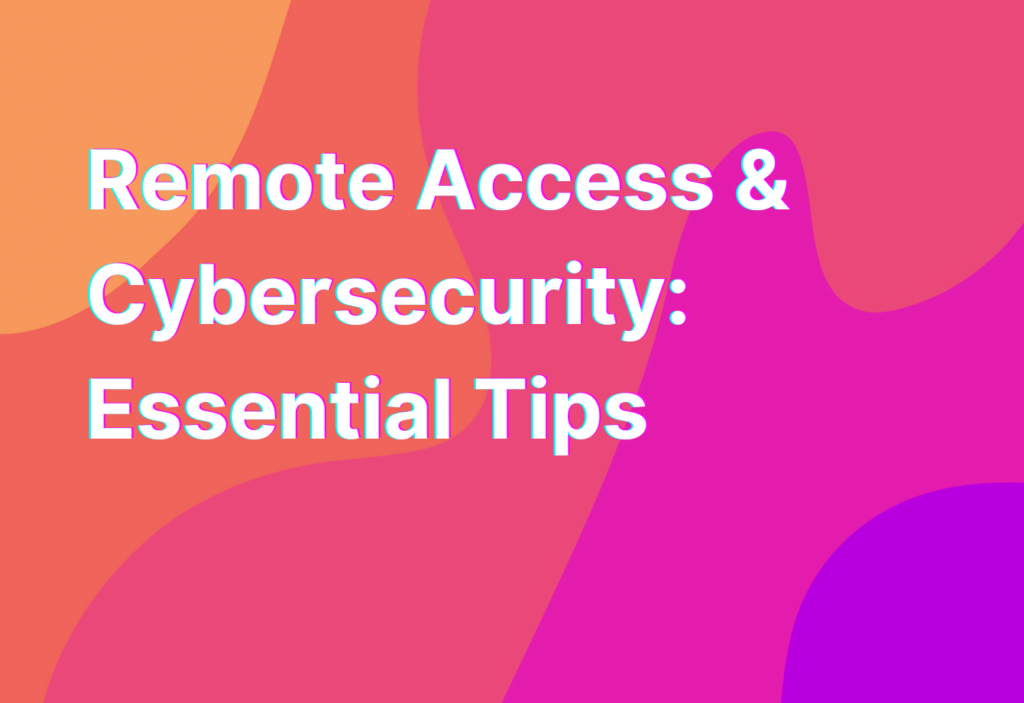Remote Access & Cybersecurity: Essential Tips
Welcome back, remote work enthusiasts! Today, we’re diving into the world of remote access and cybersecurity. As remote workers, we rely heavily on technology to connect with our teams and get our work done. But with great power comes great responsibility, and it’s crucial to prioritize the security of our remote access. So, grab your virtual seatbelt and let’s explore some essential tips to keep your remote work environment safe and secure.
1. Use Strong and Unique Passwords
Let’s start with the basics – passwords. We all know the importance of having strong and unique passwords, but it’s worth repeating. When it comes to remote access, using a strong password is your first line of defense against potential cyber threats. Avoid using common passwords like “123456” or “password” (yes, people still use these!). Instead, create a password that includes a mix of uppercase and lowercase letters, numbers, and special characters.
But wait, there’s more! Don’t use the same password for all your accounts. I know, it’s tempting to use one password for everything, but it’s a big no-no in the world of cybersecurity. If one account gets compromised, all your other accounts become vulnerable. So, take the time to create unique passwords for each of your accounts. Trust me, it’s worth the extra effort.
2. Enable Two-Factor Authentication
Now that you have strong and unique passwords, let’s add an extra layer of security with two-factor authentication (2FA). 2FA provides an additional step to verify your identity when logging into your remote access tools. It typically involves entering a code sent to your mobile device or using a biometric authentication method, like a fingerprint or facial recognition.
By enabling 2FA, you’re adding an extra barrier for potential hackers. Even if they somehow manage to crack your password, they’ll still need that second factor to gain access. It’s like having a bouncer at the entrance of your virtual workspace – only the authorized personnel get in!
3. Keep Your Devices and Software Updated
Remember those pesky software update notifications that always seem to pop up at the most inconvenient times? Well, it’s time to start embracing them. Keeping your devices and software updated is crucial for maintaining a secure remote work environment.
Software updates often include important security patches that fix vulnerabilities in the system. By neglecting these updates, you’re leaving your devices and data exposed to potential cyber threats. So, the next time you see that update notification, don’t ignore it – embrace it like a virtual hug from your cybersecurity guardian.
4. Be Wary of Phishing Attempts
Ah, phishing – the art of tricking unsuspecting individuals into revealing sensitive information. As remote workers, we’re prime targets for phishing attempts. Hackers often disguise themselves as trustworthy entities, like your company’s IT department or a popular online service, to lure you into clicking on malicious links or providing personal information.
To protect yourself from falling victim to phishing attempts, always double-check the sender’s email address and be cautious of any suspicious requests. If something seems off, trust your gut and reach out to the supposed sender through a separate communication channel to verify the legitimacy of the request. Remember, it’s better to be safe than sorry!
5. Educate Yourself and Stay Informed
As remote workers, it’s essential to stay up-to-date with the latest cybersecurity trends and best practices. Cyber threats are constantly evolving, and what worked yesterday may not work today. By educating yourself and staying informed, you can better protect yourself and your remote work environment.
There are plenty of resources available online to help you stay in the cybersecurity loop. Websites like Trello and Cybersecurity.com offer valuable insights and tips to keep you one step ahead of potential threats. So, grab your virtual reading glasses and start exploring!
Wrapping Up
Well, my fellow remote work enthusiasts, we’ve reached the end of our remote access and cybersecurity journey. Remember, remote work offers incredible flexibility and freedom, but it also comes with its own set of challenges, particularly in the realm of cybersecurity. By following these essential tips – using strong and unique passwords, enabling two-factor authentication, keeping your devices and software updated, being wary of phishing attempts, and educating yourself – you can create a secure remote work environment.
For more information on the importance of cybersecurity in remote work, check out this Security breach article on our website. Stay safe, stay secure, and keep embracing the remote work revolution!


